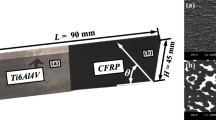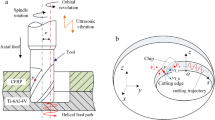Abstract
The stacked carbon fiber reinforced plastic (CFRP) laminate and metallic plate are widely used in the aerospace industry to improve structural performance and reliability. Abrasive waterjet (AWJ) machining is a promising technique for cutting hybrid metallic/CFRP stacks with high efficiency and versatility, while the machining defects including kerf taper, striation, and craters are prevalent when using the single-pass AWJ cutting method. This study aims to develop a dual-pass AWJ cutting strategy to improve surface quality and reduce machining-induced damage of Al/CFRP stacks without compromising machining efficiency. The kerf taper was respectively reduced by up to ~ 63% and ~ 37% for aluminum plate and CFRP laminate using the proposed dual-pass abrasive waterjet slotting strategy. Striations were effectively reduced, resulting in improved kerf surface quality and significantly lower maximum peak-to-valley height. Straight/smooth kerf profiles were obtained by employing the dual-pass strategy with relatively low hydraulic pressure levels.
















Similar content being viewed by others
Data availability
Not applicable.
References
Liu D, Tang Y, Cong WL (2012) A review of mechanical drilling for composite laminates. Compos Struct 94:1265–1279
Pahuja R, Ramulu M, Hashish M (2019) Surface quality and kerf width prediction in abrasive water jet machining of metal-composite stacks. Compos Part B-Eng 175:107134
Kim G, Denos BR, Sterkenburg R (2020) Influence of different piercing methods of abrasive waterjet on delamination of fiber reinforced composite laminate. Compos Struct 240:112065
Shanmugam DK, Nguyen T, Wang J (2008) A study of delamination on graphite/epoxy composites in abrasive waterjet machining. Compos Part A-Appl S 39:923–929
Sourd X, Zitoune R, Crouzeix L, Coulaud M, Lamouche D (2021) Influence of the damage generated by abrasive water jet texturing on the tensile static and fatigue behaviour of 3D woven composite in the context of repair. Compos Part A-Appl S 149:106567
Hejjaji A, Zitoune R, Crouzeix L, Roux SL, Collombet F (2017) Surface and machining induced damage characterization of abrasive water jet milled carbon/epoxy composite specimens and their impact on tensile behavior. Wear 376–377:1356–1364
Hejjaji A, Zitoune R, Toubal L, Crouzeix L, Collombet F (2019) Influence of controlled depth abrasive water jet milling on the fatigue behavior of carbon/epoxy composites. Compos Part A-Appl S 121:397–410
Li M, Huang M, Yang X, Li S, Wei K (2018) Experimental study on hole quality and its impact on tensile behavior following pure and abrasive waterjet cutting of plain woven CFRP laminates. Int J Adv Manuf Technol 99:2481–2490
Li M, Huang M, Chen Y, Gong P, Yang X (2019) Effects of processing parameters on kerf characteristics and surface integrity following abrasive waterjet slotting of Ti6Al4V/CFRP stacks. J Manuf Process 42:82–95
Sourd X, Zitoune R, Hejjaji A, Salem M, Hor A, Lamouche D (2021) Plain water jet cleaning of titanium alloy after abrasive water jet milling: surface contamination and quality analysis in the context of maintenance. Wear 477:203833
Bañon F, Sambruno A, Batista M, Simonet B, Salguero J (2021) Evaluation of geometrical defects in AWJM process of a hybrid CFRTP/Steel structure. Int J Mech Sci 210:106748
Natarajan Y, Murugesan PK, Mohan M, Liyakath Ali Khan SA (2020) Abrasive Water Jet Machining process: a state of art of review. J Manuf Process 49:271–322
Shanmugam DK, Wang J, Liu H (2008) Minimisation of kerf tapers in abrasive waterjet machining of alumina ceramics using a compensation technique. Int J Mach Tool Manu 48:1527–1534
Nandakumar NS, Sasikumar KSK, Sambathkumar M, Saravanan N (2020) Investigations on AWJ cutting process of hybrid aluminium 7075 metal matrix composites using nozzle oscillation technique. Mater Today Proc 33:2798–2802
Liao Z, Sanchez I, Xu D, Axinte D, Augustinavicius G, Wretland A (2020) Dual-processing by abrasive waterjet machining—a method for machining and surface modification of nickel-based superalloy. J Mater Process Tech 285:116768
Li HZ, Wang J, Fan JM (2009) Analysis and modelling of particle velocities in micro-abrasive air jet. Int J Mach Tool Manu 49:850–858
Chen FL, Siores E (2003) The effect of cutting jet variation on surface striation formation in abrasive water jet cutting. J Mater Process Tech 135:1–5
Li H, Wang J (2015) An experimental study of abrasive waterjet machining of Ti-6Al-4V. Int J Adv Manuf Technol 81:361–369
Wang J (1999) Abrasive waterjet machining of polymer matrix composites – cutting performance, erosive process and predictive models. Int J Adv Manuf Technol 15:757–768
Bañon F, Sambruno A, González-Rovira L, Vazquez-Martinez JM, Salguero J (2021) A review on the abrasive water-jet machining of metal–carbon fiber hybrid materials. Metals-Basel 11:164
Zhang L, Ji R, Fu Y, Qi H, Kong F, Li H, Tangwarodomnukun V (2020) Investigation on particle motions and resultant impact erosion on quartz crystals by the micro-particle laden waterjet and airjet. Powder Technol 360:452–461
Funding
This work was supported by the National Natural Science Foundation of China (52275422, recipient: ML).
Author information
Authors and Affiliations
Contributions
ML: conceptualization, investigation, funding acquisition, writing-original draft, and editing; TS: methodology, data collection, and writing-original draft; XL: data collection and methodology and data collection.
Corresponding author
Ethics declarations
Competing interests
The authors declare no competing interests.
Additional information
Publisher's Note
Springer Nature remains neutral with regard to jurisdictional claims in published maps and institutional affiliations.
Rights and permissions
Springer Nature or its licensor (e.g. a society or other partner) holds exclusive rights to this article under a publishing agreement with the author(s) or other rightsholder(s); author self-archiving of the accepted manuscript version of this article is solely governed by the terms of such publishing agreement and applicable law.
About this article
Cite this article
Li, M., Su, T. & Lin, X. Improving surface striation and kerf taper of hybrid Al/CFRP stacks using dual-pass abrasive waterjet slotting strategy. Int J Adv Manuf Technol 130, 5763–5776 (2024). https://doi.org/10.1007/s00170-024-13084-y
Received:
Accepted:
Published:
Issue Date:
DOI: https://doi.org/10.1007/s00170-024-13084-y




